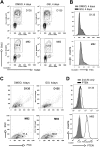Acute T-cell leukemias remain dependent on Notch signaling despite PTEN and INK4A/ARF loss
- PMID: 20008304
- PMCID: PMC2826229
- DOI: 10.1182/blood-2009-04-214718
Acute T-cell leukemias remain dependent on Notch signaling despite PTEN and INK4A/ARF loss
Abstract
NOTCH1 is activated by mutation in more than 50% of human T-cell acute lymphoblastic leukemias (T-ALLs) and inhibition of Notch signaling causes cell-cycle/growth arrest, providing rationale for NOTCH1 as a therapeutic target. The tumor suppressor phosphatase and tensin homolog (PTEN) is also mutated or lost in up to 20% of cases. It was recently observed among human T-ALL cell lines that PTEN loss correlated with resistance to Notch inhibition, raising concern that patients with PTEN-negative disease may fail Notch inhibitor therapy. As these studies were limited to established cell lines, we addressed this issue using a genetically defined mouse retroviral transduction/bone marrow transplantation model and observed primary murine leukemias to remain dependent on NOTCH1 signaling despite Pten loss, with or without additional deletion of p16(Ink4a)/p19(Arf). We also examined 13 primary human T-ALL samples obtained at diagnosis and found no correlation between PTEN status and resistance to Notch inhibition. Furthermore, we noted in the mouse model that Pten loss accelerated disease onset and produced multiclonal tumors, suggesting NOTCH1 activation and Pten loss may collaborate in leukemia induction. Thus, in contrast to previous findings with established cell lines, these results indicate PTEN loss does not relieve primary T-ALL cells of their "addiction" to Notch signaling.
Figures





Similar articles
-
Murine Pten(-/-) T-ALL requires non-redundant PI3K/mTOR and DLL4/Notch1 signals for maintenance and γc/TCR signals for thymic exit.Cancer Lett. 2014 May 1;346(2):237-48. doi: 10.1016/j.canlet.2013.12.027. Epub 2013 Dec 30. Cancer Lett. 2014. PMID: 24384093
-
Regulation of PTEN by CK2 and Notch1 in primary T-cell acute lymphoblastic leukemia: rationale for combined use of CK2- and gamma-secretase inhibitors.Haematologica. 2010 Apr;95(4):674-8. doi: 10.3324/haematol.2009.011999. Epub 2009 Dec 16. Haematologica. 2010. PMID: 20015880 Free PMC article.
-
Epigenetic regulation of the Ink4a-Arf (Cdkn2a) tumor suppressor locus in the initiation and progression of Notch1-driven T cell acute lymphoblastic leukemia.Exp Hematol. 2013 Apr;41(4):377-86. doi: 10.1016/j.exphem.2012.11.006. Epub 2012 Nov 23. Exp Hematol. 2013. PMID: 23178376 Free PMC article.
-
The relevance of PTEN-AKT in relation to NOTCH1-directed treatment strategies in T-cell acute lymphoblastic leukemia.Haematologica. 2016 Sep;101(9):1010-7. doi: 10.3324/haematol.2016.146381. Haematologica. 2016. PMID: 27582570 Free PMC article. Review.
-
New insights into Notch1 regulation of the PI3K-AKT-mTOR1 signaling axis: targeted therapy of γ-secretase inhibitor resistant T-cell acute lymphoblastic leukemia.Cell Signal. 2014 Jan;26(1):149-61. doi: 10.1016/j.cellsig.2013.09.021. Epub 2013 Oct 16. Cell Signal. 2014. PMID: 24140475 Review.
Cited by
-
Vital roles of mTOR complex 2 in Notch-driven thymocyte differentiation and leukemia.J Exp Med. 2012 Apr 9;209(4):713-28. doi: 10.1084/jem.20111470. Epub 2012 Apr 2. J Exp Med. 2012. PMID: 22473959 Free PMC article.
-
Oncogenic Notch signaling in T-cell and B-cell lymphoproliferative disorders.Curr Opin Hematol. 2016 Jul;23(4):362-70. doi: 10.1097/MOH.0000000000000254. Curr Opin Hematol. 2016. PMID: 27135981 Free PMC article. Review.
-
Focused chemical genomics using zebrafish xenotransplantation as a pre-clinical therapeutic platform for T-cell acute lymphoblastic leukemia.Haematologica. 2015 Jan;100(1):70-6. doi: 10.3324/haematol.2014.110742. Epub 2014 Oct 3. Haematologica. 2015. PMID: 25281505 Free PMC article.
-
Human cancer growth and therapy in immunodeficient mouse models.Cold Spring Harb Protoc. 2014 Jul 1;2014(7):694-708. doi: 10.1101/pdb.top073585. Cold Spring Harb Protoc. 2014. PMID: 24987146 Free PMC article. Review.
-
Resistance mechanism to Notch inhibition and combination therapy in human T-cell acute lymphoblastic leukemia.Blood Adv. 2023 Oct 24;7(20):6240-6252. doi: 10.1182/bloodadvances.2023010380. Blood Adv. 2023. PMID: 37358480 Free PMC article.
References
-
- Maillard I, Fang T, Pear WS. Regulation of lymphoid development, differentiation, and function by the Notch pathway. Annu Rev Immunol. 2005;23:945–974. - PubMed
-
- Grabher C, von Boehmer H, Look AT. Notch 1 activation in the molecular pathogenesis of T-cell acute lymphoblastic leukaemia. Nat Rev Cancer. 2006;6(5):347–359. - PubMed
-
- Weng AP, Ferrando AA, Lee W, et al. Activating mutations of NOTCH1 in human T cell acute lymphoblastic leukemia. Science. 2004;306(5694):269–271. - PubMed
Publication types
MeSH terms
Substances
Grants and funding
LinkOut - more resources
Full Text Sources
Molecular Biology Databases
Research Materials

